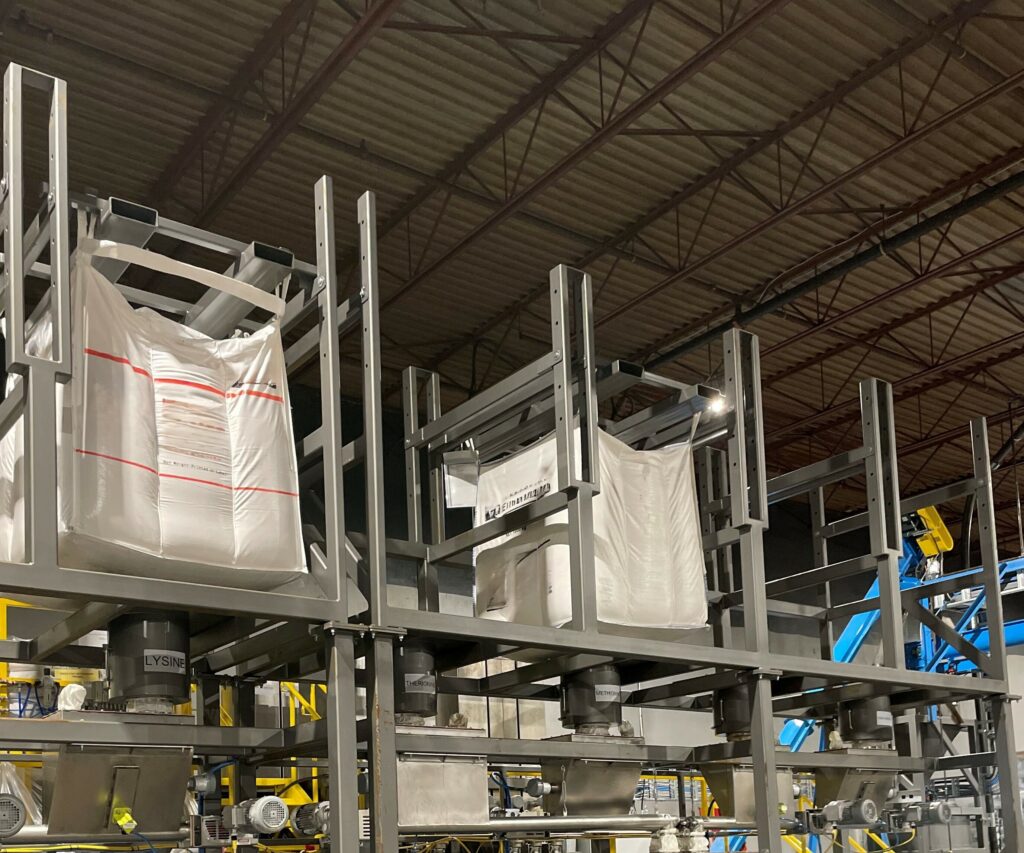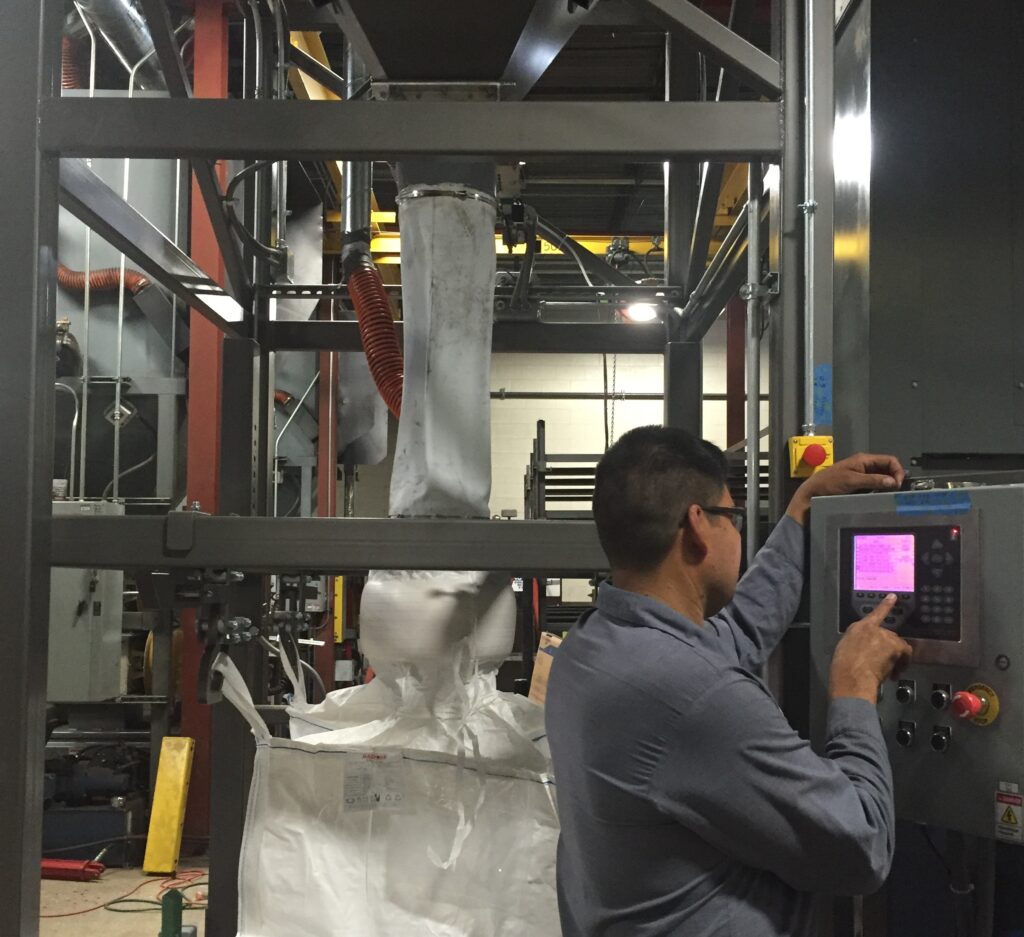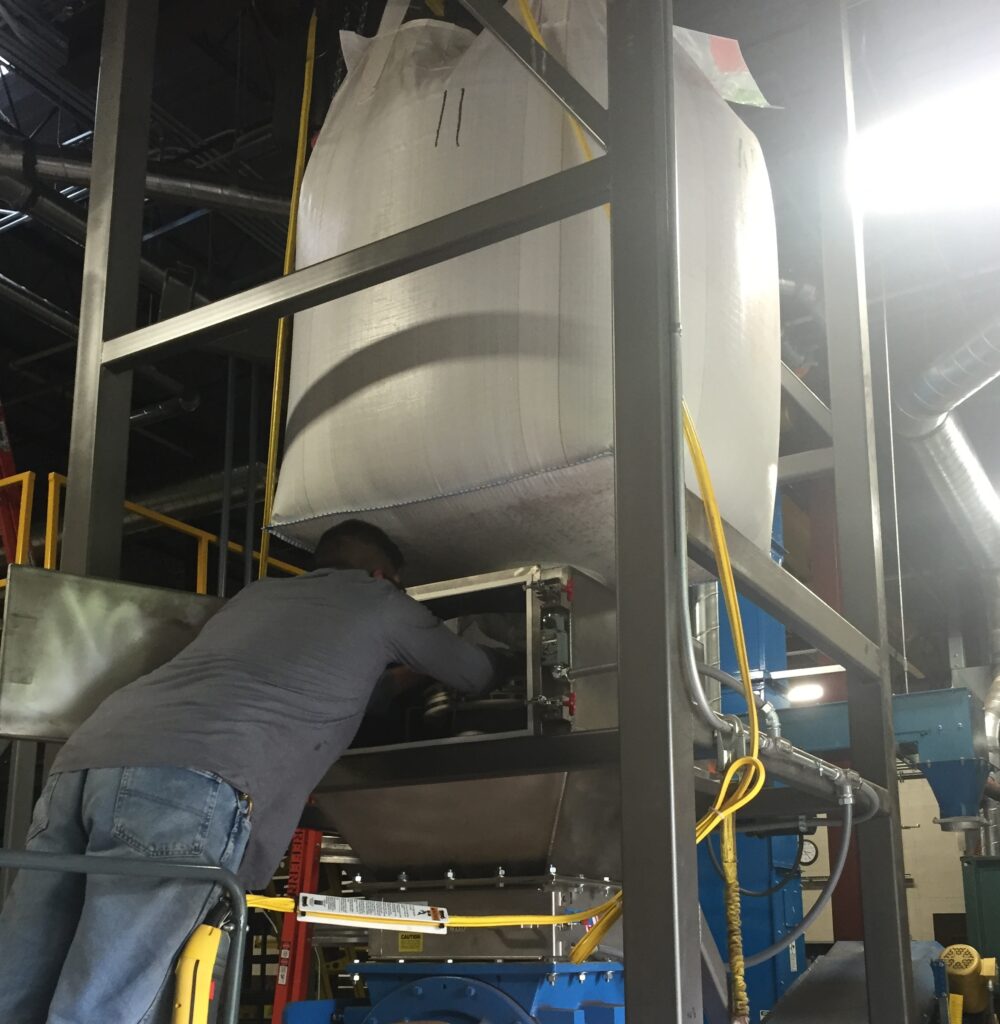Bulk Bag Handling: From Filling to Unloading
Efficient management of bulk materials is critical in process industries to ensure smooth operations and enhance productivity. Bulk bag handling—a vital component of bulk solids management—requires reliable and effective equipment to ensure seamless processing from filling to unloading/discharging. Suppliers that excel in providing bulk bag handling equipment offer a comprehensive range of solutions designed to optimize the filling and unloading/discharging of bulk bags. In this post, we’ll explore the use of bulk bags, their benefits, and the key things to consider in filling and unloading to improve your process management, ensuring quality and operational efficiency.
What Is Bulk Bag Handling?
Bulk bag handling involves managing large quantities of dry materials (powder or granular) packed in Flexible Intermediate Bulk Containers (FIBCs), commonly known as bulk bags. Designed to hold substantial volumes of dry bulk solid materials, these bags are ideal for industries needing to transport, store, and process large amounts of material. The bulk bag handling process is required by companies producing their product in large volumes, thereby requiring the filling of bulk bags, and required by companies that use dry materials in large quantities within their process and need to unload or discharge the dry bulk material from the bags. Efficient filling and unloading process management is crucial to prevent spillage, contamination, or delays that could impact productivity.
Benefits of Bulk Bags

Bulk bags offer several advantages over traditional packaging methods, making them popular in various industries. They can hold between 1,100 to 4,400 pounds (500 to 2,000 kilograms) of material, reducing the need for pallets of smaller bags and minimizing handling time. Using bulk bags is generally more cost-effective than multiple smaller bags or containers, lowering both material and shipping costs. Durable and reusable bulk bags help lower waste, and many are made from recyclable materials, promoting sustainability. Bulk bag handling equipment is critical to the companies that use them.
To aid in the filling or unloading/discharging of bulk bags, the bags are equipped with integrated lifting loops so that the bulk bags can be moved easily with forklifts or cranes, simplifying the handling process before and after the filling or unloading process. This helps improve productivity and reduce manual labor. Additionally, bulk bags often feature dust-tight closures and anti-static properties, reducing contamination risks and enhancing handling safety. They can also be customized to meet specific needs, including size, material, closure, and discharge type, making them versatile for bulk materials and handling requirements.
Bulk Bags in Ingredient Batching Systems
Bulk bags play a crucial role in ingredient batching systems, essential for accurately measuring and mixing ingredients in industries such as food processing, pet food manufacturing, livestock feed production, pharmaceuticals, and chemicals. Ingredients that are added to recipes and formulas in large weighment amounts are used in high volume, hence the use of bulk bags. Proper bulk bag unloading/discharging is crucial for maintaining precision in ingredient batching systems. Bulk bags offer an alternative to sizeable dry bulk storage silo systems. They can easily be incorporated into minor ingredient batching systems to store ingredients required in larger quantities than typical batching system bin storage, which is filled manually from smaller bags. Bulk bag unloading solutions need to be efficiently incorporated into the batching system to reduce manual filling and small bag handling and to ensure consistent ingredient quality.
For micro ingredient systems, which handle very small quantities with high precision, the bulk bag unloading/discharging systems are designed to manage delicate micro ingredients accurately and hygienically. This supports high-precision batching and maintains product quality, which is essential for industries that require meticulous ingredient management.
Top 5 Essentials for Efficient Bulk Bag Handling Equipment
Optimizing bulk bag filling and unloading/discharging ensures efficiency and safety. Here are five essential elements crucial for effective bulk bag handling equipment. Check with your supply partner to ensure they have these requirements covered.

- Durable Bulk Bag Frames: Well-designed and sturdy frames are essential for ensuring proper equipment function and maintaining the shape of bulk bags during filling and unloading/discharging. They provide the necessary support, prevent collapses, and ensure smooth material flow while minimizing the risk of spills or jams. They must be designed for the load, physical space limitations, the bag handling equipment features and functions, and to withstand any material contact and the environment.
- Accurate Weighing Systems: Precision in weighing systems is critical for managing the correct amount of material when filling each bulk bag. Accurate measurements help avoid errors, streamline inventory management, and ensure that each bag is filled or emptied as intended. Standalone systems for unloading bulk bags often include material weighing/dosing capabilities and conveying the discharged material downstream to the next process step. Bag unloading incorporated in ingredient batching systems will have material weighing built into the batching system along with the bag hanging and unloading mechanisms.
- Efficient Bag Suspension Systems: Make sure you consider how you will hang/suspend the bags for your unloading/discharging system. Proper suspension systems for hanging bags are vital for handling bulk bags safely. Some companies opt for hanging the bulk bags using a forklift truck, while other companies choose to use a hoist. These suspension systems need to be robust enough to handle the size and weight of the bags, as well as the suspension height, to ensure safe, smooth, and strain-free operations.
- Automated Filling and Discharging Equipment: Automation plays a significant role in enhancing the efficiency of bulk bag handling. Automated fillers, vibrators, and dischargers reduce the need for manual intervention, increase throughput, and minimize errors, leading to more consistent and reliable operations. Automatic bulk bag massagers can be necessary to ensure smooth unloading, especially where material with flow problems is involved. These massagers (typically one for each side of the bag) will push up from the bottom sides and help distribute the material during discharge to aid the material flow. Another example is the use of automatic bag accumulators in bag-filling equipment. This allows for the repetitive filling of bulk bags without removing each bag from the equipment before another bag can be filled.

- Effective Dust Control Systems: Dust control is crucial for maintaining a clean and safe workspace. Many powders are toxic or explosive and can fill the environment during bag connection and unloading/discharge, leading to unsafe conditions. Reliable dust containment and collection systems help manage airborne dust, protecting the environment and personnel from dust-related issues. Features included in bulk bag handling equipment for bag unloading include containment enclosures that provide access to the bag discharge “tail” opening, attachment to the unloading system, and connection to dust collection system duct work. Potential dust problems must be considered in advance and custom-engineered as a solution to potential dust problems in your bag unloading system.
Investing in these essential areas dramatically improves the efficiency and safety of bulk bag handling equipment operations, making material processing more effective and controlled.
Conclusion
Efficient bulk bag handling equipment is crucial for optimizing material management processes in various industries. From the initial filling to the final unloading, each stage of handling bulk bags plays a significant role in ensuring productivity, quality, and safety. By focusing on the fundamental essentials—durable bag frames, accurate weighing systems, effective suspension methods, automated equipment, and robust dust control systems—companies can significantly enhance their operations.
Investing in high-quality equipment and systems that address these essentials streamlines bulk bag handling and minimizes spillage, contamination, and dust risks. This approach ensures that materials are managed effectively, processes run smoothly, and maximizes operational efficiency.
Incorporating these proven methods and considering specific needs related to your bulk materials can improve performance and safety in your dry bulk handling operations. Whether dealing with large-scale production or precise ingredient batching, a well-optimized bulk bag handling system is integral to achieving operational excellence and maintaining a productive and safe work environment.
Next Steps
To improve your bulk bag handling operations, start by assessing your current systems to identify areas for improvement. With over 50 years of expertise in custom engineering bulk bag handling equipment and systems, process control, material weighing, ingredient batching, liquid handling, and other bulk material handling solutions for a wide range of process industries, Sterling Systems & Controls proudly has the experience to provide you with expert guidance to achieve your automation and process improvement goals. Contact us today to discuss how our knowledge and expertise can align with your goals and how you can continue your journey toward manufacturing excellence!